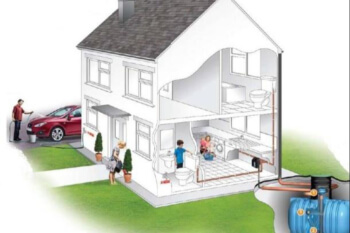A thirst for water management
09/08/2018 – Neil Robinson-Welsh – Source : LocalGov
Over the past few years we’ve heard endless rumours about the potential commencement of Schedule 3 of the Flood and Water Management Act 2010. For the uninitiated, this is the missing piece of the jigsaw that would give coherence and clarity to all those involved in delivering effective flood protection and resilience in England and Wales.
After years of endless debate, and some would argue procrastination, are we beginning to see some positive steps forward?
There appears to be no appetite to commence Schedule 3 of the Flood and Water Management Act in England, but the recent publication of Sewers for Adoption 8 and changes in local authority planning requirements we are beginning to get closer to joined up thinking and delivery of SuDS as the wider legal interpretation of a ‘sewer’ will allow water companies to adopt a wide range SuDS components.
 It is also excellent news that Wales has decided to grasp the nettle and commence this part of the act from January 2019, perhaps what is most interesting though is that there is now an acceptance that the extremes of water management should be simultaneously addressed where possible. The UK has distinct weather patterns, the western side is dominated by an Atlantic climate and the eastern side by a more Continental one, this can lead to different priorities in terms flooding and water stress.
It is also excellent news that Wales has decided to grasp the nettle and commence this part of the act from January 2019, perhaps what is most interesting though is that there is now an acceptance that the extremes of water management should be simultaneously addressed where possible. The UK has distinct weather patterns, the western side is dominated by an Atlantic climate and the eastern side by a more Continental one, this can lead to different priorities in terms flooding and water stress.
To address these two issues, Sewers for Adoption 8 refers to government advice to local authorities in relation to the ‘hierarchy of drainage connection’, this requires developers to examine the potential of re-using storm water before discharging it to ground or to surface water sewer.
Parts of the UK – predominantly London and the South East – are already ‘water stressed’. According to recent studies, London is the 9th most water stressed city in the world, such is the scale of the problem that Thames Water currently needs to find an additional 326m litres per day by 2045 to accommodate the forecasted population growth of London. The draft London plan actively seeks to address this issue with the inclusion of greywater recycling and rainwater harvesting as a means of reducing water demand.
Indeed, more recent reports such as the Policy Connect ‘Bricks and Water’ argues that we need to reduce water demand per person as part of an overall plan that allows us to build the number of homes we need in England whilst ensuring that we improve flood resilience and water availability.
It is hoped that over the coming months more local authorities will update their planning documents to adopt this hierarchy of connection, but a change in Building Regulations (Section H3) would surely help resolve this issue.
Climate change and population growth account for the mounting problems we face in the UK and these present both challenges and opportunities for the construction industry. The challenge is to think as holistically as possible, whether on development or catchment scale, to deliver multiple benefits to stakeholders and to minimise or eliminate the potential for flood and drought.
Advances in technology present an opportunity to adopt innovation to overcome such challenges in a financially viable manner. As individuals we seem to be comfortable using ‘smart’ technology in our everyday lives, some might go further and argue that these technologies dominate our lives. However on an company or organisational scale different attitude seems to emanate – there seems to be a reluctance to embrace the opportunities and solutions they can provide.
Rainwater harvesting has suffered mixed fortunes in the UK over the past 15 years, The Code for Sustainable Homes brought the technology to everyone’s attention, but as soon as this Code was dropped in 2008 so did rainwater harvesting. Now however we see a resurgence of this technology but on a much larger scale than before.
The advent of ‘smart’ weather based real time control systems allow engineers to utilise the attenuation storage on a development as a combined rainwater harvesting tank without the need to increase the tank volume. This significantly reduces the cost of incorporating this technology on a building with a high water demand. If you utilise not just the roof water, but also any treated water from hard standings then you can easily double or treble the potential yield from the site.
The mains water saving created by these two factors combined can give a financial payback of under five years, and if there are financial incentives (infrastructure charge reductions) offered by utility companies to reduce water demand then this can easily be under two years.
There are however many other benefits to this type of rainwater harvesting system particularly in flood risk reduction, it can help meet the 5mm interception threshold, and/or the potential to eliminate wet weather discharge from the site completely. The incorporation of ‘smart’ rainwater harvesting may also allow developers meet planning requirements that might otherwise have seemed impossible.
If you thought this technology was new then you might be surprised to learn that weather based real time controls have been used widely in the USA for nearly 10 years and have been proven to work from site to catchment scale delivering multiple benefits including flood control / CSO mitigation, water efficiency – water re-use, and improvements in water quality by increasing residence time in ponds.
Changes in water charging, and an opening up of the water market this will only encourage retrofitting of weather based real time control systems to reduce the rate and timing of surface water runoff in vulnerable areas. It gives the additional opportunity for businesses to save money on water bills dependant on the local utility company and their charging scheme, by reducing the impact and volume of surface water discharge into sewers.
The advent real time control systems in the UK will allow engineers and building occupiers to maximise the efficiency of the drainage infrastructure for both non-potable water re-use and flood control and will move the industry away from static and defined discharge targets towards networks that can be easily adapted to improve and meet multiple goals long into the future.
Neill Robinson-Welsh is business development director at Aquality Trading & Consulting Ltd.
Get in touch with Neill on LinkedIn
Source : LocalGov

